














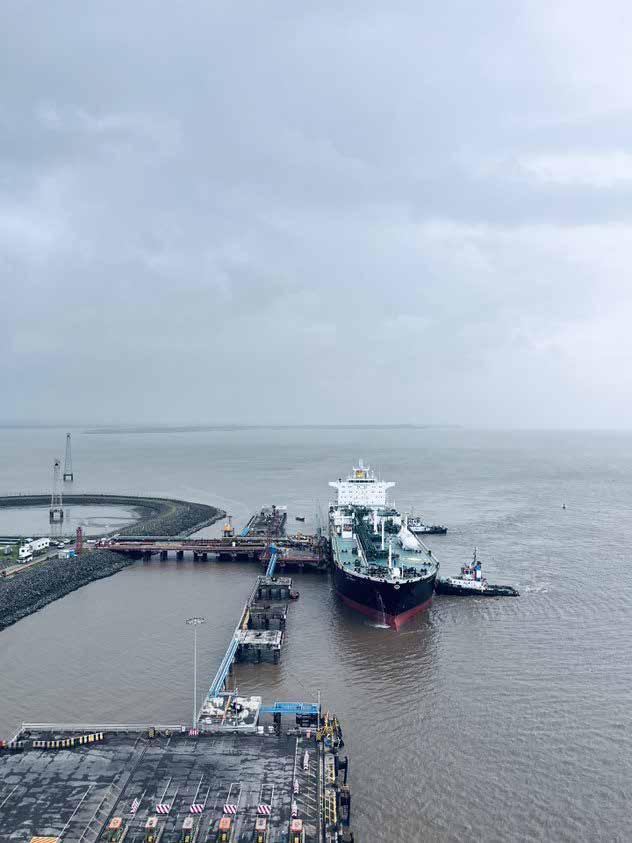
APM Terminals Pipavav (GPPL - Gujarat Pipavav Port) achieved a significant milestone by commencing Very Large Gas Carrier (VLGC) operations with the maiden berthing of MT Jag Viraat earlier this month. MT Jag Viraat, owned by Great Eastern Shipping Company, is a VLGC vessel with an impressive 230 meters length and 37 meters beam, arrival draft of 8.2 meters and a displacement of 47,260 MT.

The VLGC vessel MT Jag Viraat loaded cargo from Ruwais, ADNOC Refinery Jetty, and discharged 21,907 MT parcel at port Pipavav for major three Public Sector Undertakings (PSUs) – Bharat Petroleum Corporation Limited, Indian Oil Corporation Limited, and Hindustan Petroleum Corporation Limited. With a major shift in All-India LPG imports to VLGC vessels from earlier Medium Gas Carrier (MGC) ships, the VLGC handling capability at APM Terminals Pipavav becomes critically important, allowing Oil Marketing Companies (OMCs) to maximize their LPG imports efficiently and safely.
Commenting on berthing of the VLGC Vessel, Mr. Girish Aggarwal, MD, APM Terminals Pipavav said,” We are proud to welcome the maiden VLGC vessel at APM Terminals Pipavav port. The demand for LPG is
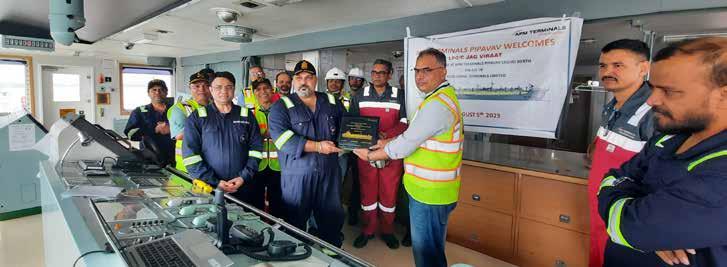
increasing as the Indian households are shifting to LPG as household fuel thanks to the Pradhan Mantri Ujjwala Yojna.
This feat reinforces our unwavering commitment to offer world-class infrastructure and services to our valued customers. The introduction of the VLGC compliant berth facility will help us bringing in large vessels with larger parcel size to get economy of scales. Besides our DFC compliant LPG rakes help in distributing LPG cargo to the remote hinterland safely via environment friendly train connectivity. We look forward to contributing to the growth of India’s energy sector through our ongoing investments in infrastructure development.”
GPPL has already announced the development of a dedicated VLGC compliant LPG Berth in March 2023, with readiness expected by 2025, along with the expansion of the LPG Terminal capacity by its terminal partner, Aegis Vopak Terminal Limited. The expanded terminal capacity is set to handle up to 3.20 million MT, further bolstering APM Terminals Pipavav’s capabilities in handling LPG imports.



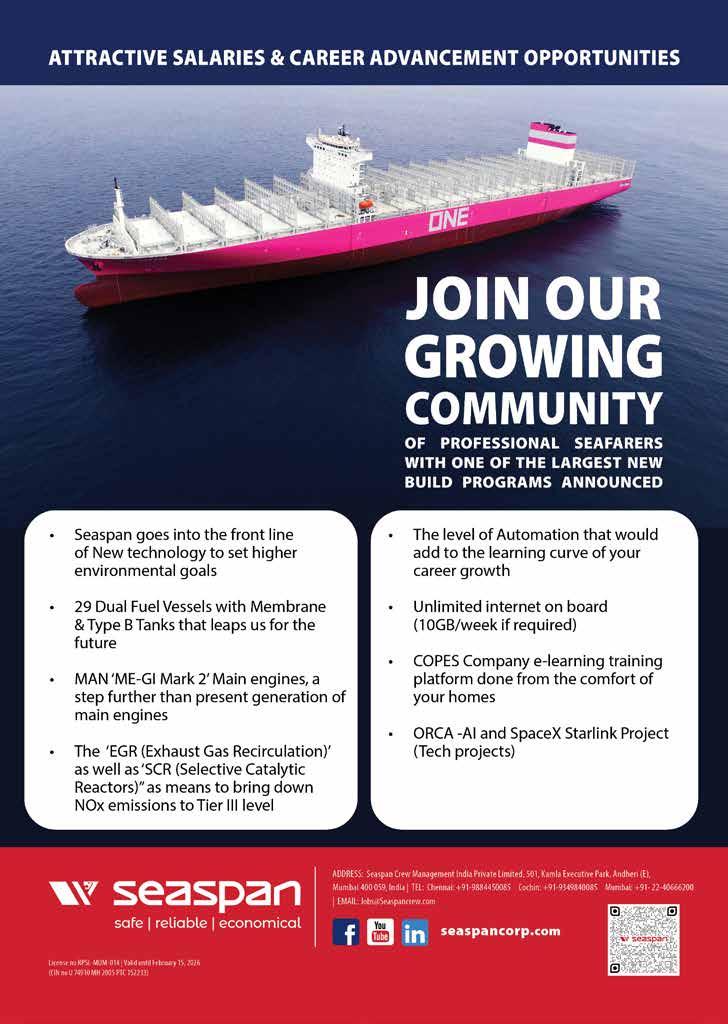

APM Terminals Pipavav is raising the bar higher in rail operations by creating new milestones during the month of July 2023. The port handled the highest number of trains this year, reaching an impressive count of 206. One of the significant accomplishments was loading 166 Double Stack (DS) trains, surpassing the port’s own previous record of loading 157 double stack trains in 2020.
It is noteworthy that 80% of the trains moved out from the port were Double stack during the month. This remarkable feat not only showcase its excellence in optimizing cargo movement but also underscore the port’s unwavering commitment to environmental sustainability. By handling an impressive number of trains and throughput, the port has effectively reduced nearly 50,000 containers on the road, leading to decongestion of traffic and a substantial reduction in carbon footprints.
“We take immense pride in achieving these remarkable milestones in our rail operations,”
stated Mr Girish Aggarwal, Managing Director, APM Terminals Pipavav. “As congestion challenges continue to impact the industry, our relentless focus on providing seamless and efficient rail connectivity through state-of-the-art infrastructure becomes even more crucial. The collaborative efforts of our team, our valued partners and stakeholders, have been instrumental in driving our success, and we remain dedicated to offering our customers unparalleled rail infrastructure and services amidst the changing landscape of trade.
The Port is well connected to Inland Container Depots (ICDs) in the northwest, totalling to 52, facilitating the customers in remote hinterland to connect with the global markets. More than 13 Container Train Operators (CTOs) run the trains to/from the port to the various ICDs in northwest, enhancing rail transportation network across the region. Besides, the port has efficiently handled exclusive block trains for renowned shipping lines such as ONE, MAERSK, and OOCL. These specialized services exemplify the port’s commitment to providing tailor-made solutions that meet the diverse needs of its esteemed customers.








Indian Register of Shipping (IRS), a leading international ship classification society, has secured an order for providing classification services for six hybrid electric catamarans for the Inland Waterways Authority of India (IWAI). The vessels will be constructed at Hooghly Cochin Shipyard Ltd., Kolkata.
The six vessels are intended for providing inland ferry services, with a capacity of 50 passengers each. They will be propelled by electric motors powered by Lithium-Titanium Oxide (LTO) batteries and diesel generators, operating in a hybrid mode, providing electrical power to propulsion motors and other ship systems. The batteries are also capable of being charged by electric supply from a shore grid when the vessels are berthed on jetties. The vessels will be assigned the additional Class notation “BATTERY PROP” which is assigned to vessels where the battery systems are used for ship propulsion and are in accordance with the rule requirements.
IRS has published Guidelines for Battery Powered Vessels which provide requirements for effective installation and safe operation of Li ion battery systems, through mitigation of the risks, from the design stage to onboard installation and operation of battery systems.

There is a growing trend in use of battery power for vessel propulsion/auxiliaries to promote sustainable means of transport. To ensure that battery systems meet the stringent marine requirements, IRS has published Class Notes for Approval of Li-ion Battery Systems, which are based on international standards.
Cdr K Dhawan (Retd), Head Defence, stated ‘IRS is fully geared to work with industry on renewable energy and hybrid propulsion systems and to promote the use of alternate fuels. IRS is committed to support the ‘Make in India’ and ‘Atma Nirbhar Bharat’ call given by Hon’ble Prime Minister in the field of efficient green propulsion solutions and for providing its clients with associated rules and guidelines’.


The Baltic Exchange has been working closely with the Clearing Houses (CCP’s) EEX and SGX to transition open interest settled on its discontinued Panamax 4TC (P4TC) index to its P5TC index.
SGX and EEX will suspend their P4TC 2028 calendars, which have zero open interest, on 31 July 2023. The CCPs are working with their clearing members and the FFA Brokers’ Association (FFABA) to transition open interest in P4TC calendars 2027 and 2026 to P5TC. The P4TC calendar contracts will be suspended immediately on completion of the transition. Open interest for 2025 will subsequently be addressed. Fees for these transactions will be waived by both CCP’s and FFABA brokers.
Baltic Exchange Chief Executive Mark Jackson commented, “Although no longer reported independently, most Panamax related FFA trading still happens on our P4TC index. Whilst we have established a differential between the two indices, in the longer term it makes sense for traders to settle directly against our P5TC assessments. We want to support an orderly transition to the P5TC.”

In January 2020 the Baltic standard Panamax vessel became an 82,500 dwt type and the weighted averages based on five routes. A fixed differential of US$ 1336 was established between P4TC and P5TC in April 2021 and since then the Baltic Exchange has been reporting P4TC as a differential to the P5TC rates.
Welcoming the initiative, John Banaszkiewicz, Chairman of the FFA Brokers Association said, “Ships and their routes evolve and it’s important that the Baltic’s indices reflect this, which is why these types of changes happen. Currently, the Panamax 5TC market is a mirror image of the physical market, based on panellist returns. The 4TC offers no transparency: it remains a number differential. Given the number of index-linked physical vessels fixed on the 5TC assessment, it is necessary for the FFA market to make the transition and adapt accordingly. Looking ahead, we anticipate that future modifications to vessel specifications will be automatically implemented following consultation with the marketplace.”
Offshore Oil and Gas - an industry of staggering proportions, supplies the energy needs for all nations, providing employment, wealth, and security for millions of families. Few really appreciate how dynamic and technologically driven it is and how it touches many parts of our lives. The offshore support vessels,
being highly complex and specialised, form a part and parcel of this truly global business.
Intricate in design, offshore vessels are the work horses of the Oil and Gas industry. Several advancements have led to newer ship designs and guidelines embracing safety, increased cargo movement, longer transit distance, increased reliability and redundancy and legislative demands.
The growth in the use of semi-submersible drilling rigs produced a demand for specialist anchor handling vessels. Development in drilling techniques produced a need to carry a variety of drilling fluids, while improvements in onshore logistics, and pipe laying capabilities created a demand for larger platform supply

vessels. The increase in subsea construction and inspection, repair and maintenance operations drove the need for efficient vessels to support remote operated vehicles and other specialist vessels.
Offshore vessels play multipurpose roles – from acting as a cargo ship, a tanker, to a passenger vessel, survey vessel, a tug, a crane vessel, a diving support vessel, an emergency response and rescue vessel or an oil spill response vessel. For example, under the same employment, an offshore vessel many be required to carry passengers, dry cargo on deck, fuel in its tanks and act as tug simultaneously. Another example could be a vessel being operated as a crane vessel while concurrently supporting diving operations.
The Indian Offshore Industry is controlled by the Oil and Natural Gas Corporation being the only major exploration and drilling company in India. This leverage affects charter rates due to lack of opportunities with other oil majors. The charter hire fluctuations due to oil prices and supply and demand issues is especially volatile on spot charters. Presently most charters are for 3 years. To offset the volatility, it is preferable to have contracts of 5 years.
Ship owning is capital intensive. With age limits of assets being constantly revised from 30 years to 25 to 21 to 19 and now to 15, the issue facing owners today is not the sheer number of vessels but the age and quality of available tonnage and whether owners can raise the capital to invest in newer, cleaner vessels for future offshore operations as Exploration and Production businesses continue to focus on age restrictions and lowering of overall emissions. For this, the government needs to promote the indigenous shipping industry by providing subsidies for ship building in India.
The time spent in obtaining clearances makes it tedious for an Indian flagged vessel, with Indian crew holding Indian passports to step into spot charters as it takes 50-60 days to clear all compliances. Police verification is required for every seafarer even though he/she has a valid passport. This verification can take anywhere between 15 to 30 days, following which a Non-Employee Duty (NED) pass is processed by ONGC which takes about 7 days.
Vessels are required to have Ministry of Defence (MOD) clearance which needs to be applied 30 days in advance of the charter, while Naval Security Clearance (NSC) is to be applied 7 days in advance of the charter, however only after receiving MOD clearance. E-applications and data analytics are required, to reduce lead time for first time vessels requiring Naval Clearance. Fast track clearances should be available to Indian Flagged vessels already working for a contract.
Shortage of trained personnel is another issue that needs to be investigated. Though most seafarers prefer main fleet due to experience gained in cargo work and calculation of sea time for deck cadets in particular; many have moved to offshore during the boom in the industry. However, the current slump has seen many migrating to main fleet.
Complex operations such as towing, and anchor handling require skilled manpower which is lacking. Though individuals are trained in DP operations, manual handling guarantees a fall-back mechanism in case the DP system becomes non-operational. To ensure skilled manpower, economical simulation training is required to cater to the needs of diversified offshore operations.
Offshore vessels have complex and numerous machinery. Maintenance of these machinery involves obtaining spares from Japan, South Korea, China, Scandinavian countries, Europe, and USA. Covid 19 has led to disruption in supply chain and long lead periods in importing spares, thereby escalating costs in repairs and maintenance. Most spares are not available off the shelf due to scarcity of raw materials thus impeding manufacturing. The regularisation will take time to reduce lead-time in procuring spares to pre-pandemic levels.
Another pain point is Ship finance. Indian financial institutions have a negative outlook in funding asset purchase. Banks enforce stricter lending conditions with high interest rates. Further the high cost of ship building, and long lead periods incurs higher financing costs.
The term for Indian rupee loan is 7 years and for a foreign loan is 5 years. There is a need from the Government of India to recognize shipping as an infrastructure sector, thereby facilitating
loans for a longer term – minimum of 10 years to withstand charter hire fluctuation.
Further banks do not consider the ship as a full collateral and require other guarantees and collaterals. Additionally, they tend to lend only against a contract. Whereas an Indian flagged vessel is required to bid for a contract. A catch twenty-two situation which doesn’t augur well for an offshore ship owner. Government support through a mechanism providing cheaper loans, longer repayment periods and initial moratorium for one year on repayments as tender finalizations take about 6 months, would be a welcome initiative.
Today the offshore industry is not just about oil and gas. The current energy crisis has led to an acceleration in the clean energy sector. Investment into clean energy could be anywhere between 2 Trillion to 4 Trillion USD to honour the global commitment of bringing down the temperature to 1.5 degrees above the base line temperature. By 2030 fossil fuel consumption is expected to peak and reduce to 70% of the total energy consumption.
Offshore wind power offers a plausible alternative in such a scenario. Globally, offshore wind power is 2 decades old, with 2021 being the best year ever. GWEC has raised its outlook for 2030 by 16.7% which equates to another 45GW of capacity. China made up 80% of offshore wind capacity worldwide in 2021, bringing its cumulative offshore wind installations to 27.7 GW. By the end of 2022, Asia will be the world’s largest offshore market. It could take until 2031 for Europe to regain the position. There is bid globally to increase to 260 GW by 2030.
India’s plan to call for 5,000 megawatts of offshore wind by 2022, and 30,000 megawatts by 2030 has seen little progress due to lack of developed port infrastructure, higher costs of installing turbines and suspensions due to the pandemic. This is despite a 7,600 km-long coastline, and an offshore wind energy potential of 140 GW by 2050. Of this, Gujarat and Tamil Nadu make up 71 GW.

Service Operation Vessels cater to the offshore wind farms. These vessels offer solutions for the entire offshore renewables value chain including offshore wind, tidal and wave power. Particularly, windfarm support vessels have a high focus on
efficient logistics, crew and technician comfort, operability and gangway connected uptime. Features of a Service Operation Vessel include:
* Adjustable Gangway
* Motion compensated Crane.
* Premium Cabin Accommodation (40-100).
* Optimized hull and solar cells.
* Emission Free propulsion.
* Battery hybrid propulsion.
Offshore support vessels have come a long way since the first vessel ‘Ebb Tide” built in 1956 to service the US Gulf Offshore. The global search for hydrocarbons and sub-sea minerals is moving into ever increasingly deeper water and harsher environment such as the Arctic. To tackle these extreme weather conditions the design and guidelines of offshore vessels continues to evolve. As we move into the future, the growing renewable energy market will see this industry thrive and expand long after the depletion of fossil fuels.
Wista is a fantastic global platform for women in shipping. One of the common key goals of Wista across all geographies has been counselling and mentoring of women, which I would like to highlight as a major action area for the welfare of women in the industry.
Becoming an office bearer of Wista was more of a calling towards bringing a change in the maritime industry and encouraging more women to be a part of this industry, which pre dominantly remains male dominated.

• Wista Girl Boss Pitch Series :it’s a platform for our members to engage and make a business pitch about their respective business/ work/ area of expertise. The members of Wista India and Wista Sri Lanka participate in these sessions.
• Wista meet and greet and knowledge sessions : we started this initiative last year in August and successfully hosted 2 such meets-one on finance equity investments and other on value selling . The upcoming sessions are expected to be on HR, Digital Marketing , Sales, Logistics Tech
• Engagement with overseas Wista Associations : Wista Malaysia, Sri Lanka, Singapore ,Philippines. Sanjam has made a lot of efforts in past getting these meetings and in a recent president meet of the Asia Pacific region it has been agreed to increase these engagements
• Wista India Podcast: Opportunity to record your own podcast which is shared within different segments of the industry
• Networking meets on Wista India Anniversary and Womens’ Day : we believe that these celebrations help build lasting friendships and camaraderie, and over the years have truly strengthened our network.
Wista India is truly proud to mention some praiseworthy women in maritime who have broken glass ceilings by excelling in their respective fields of expertise

- Mrs HK Joshi – ex CMD of SCI in Liner Shipping , Vinita Venkatesh in the field of Ports, Infrastructure and International Logistics , Mrs Malini Shankar in Education and Maritime Reforms and Sanjam Sahi Gupta in the field of NVOCC and Maritime Education.
Author Summiit Cheema President, WISTA IndiaDisclaimer
All advertisements in this magazine are placed with no liability accepted by the publisher for the material content therein. No responsibility is accepted by the publisher for omission or error or non-insertion of any advertisements. All advertisements and material in this magazine are subjected to approval by the publisher and are not necessary the opinion of the publisher. No liability is accepted for advertisements that are placed or any information that might be criminally connected. All information is checked to the best of our knowledge and is reliant upon the material submitted not being in contravention of all relevant laws and regulations and within the provisions of the Trade Practices Act.
Reproduction Prohibited
Maritime Matrix Today will not be responsible for the views expressed by contributors in their personal capacity. All rights reserved.
in part or whole without the permission of the Editor is prohibited.
Readers are recommended
To make appropriate enquiries before sending money, incurring expenses or entering into any commitment in relation to any advertisement published in this publication. Maritime Matrix Today does not vouch for any claims made by the Advertisers of Products and Services.


Owner of Maritime Matrix Today shall not be held liable for any consequences, in the event such claims are not honoured by




You always have two choices. With ignorance you may endanger, whereas when you act out of awareness you can always end danger. The power lies with what you choose. Cyber threats are real. We know how to protect you. We rest our case.
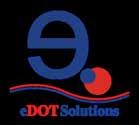




Taking ahead its vision of conserving nature, promoting biodiversity, and protecting oceans, DP World, a leading provider of worldwide smart end-to-end supply chain solutions, will nurture 15,000 school students and youth to become Ocean Protection Ambassadors. This initiative celebrates the spirit of World Nature Conservation Day by addressing the rising issue of plastic waste ending up in the oceans by driving behavioural change at the community level. Plastic waste makes up 80% of all marine pollution and around 8 to 10 million metric tons of plastic end up in the ocean each year. By fostering a young force of nature conservationists, DP World expects to prevent plastic waste from entering the ocean waters. To this effect, DP World’s beach clean-up drives across Mundra, Cochin and Nhava Sheva witnessed over 200 employees partnering with local communities to clear over 300 kilograms of land-to-ocean plastic waste.

Speaking on the initiative, Mr Kevin D’Souza, Vice President, Business Development, DP World, Subcontinent, “Our employees in India and around the world strongly believe in our sustainability
commitment towards ‘Our World, Our Future,’ and recognize the importance of adopting sustainable practices. At DP World we are reinforcing our sustainability commitments through various initiatives to promote biodiversity and conserve nature, for which we partner with the communities in our operating locations to co-create a better tomorrow. We appreciate our employees, for supporting and contributing to the cause of protecting our oceans.”
Additionally, in line with the theme of World Nature Conservation Day 2023, ‘Forests and Livelihoods: Sustaining People and Planet’, DP World provided thermal drones and two patrolling vehicles to the Tadoba-Andhari Tiger Reserve in Maharashtra, India. These interventions are improving patrolling capabilities at the tiger reserve and playing a significant role in the prevention and early detection of forest fires and helping reduce human-wildlife conflict.
DPWorld, a leading global provider of smart end-to-end logistics, welcomed the newly launched weekly India Middle East Service (IMS/IM1) at its state-of-theart Nhava Sheva and Mundra Terminals. WAN HAI Lines and Unifeeder will operate a weekly service to Jebel Ali. With a weekly capacity of 1700 TEUs, the
new service will enhance the connectivity between the West Coast of India through Mundra and Nhava Sheva, and the Middle East.
The inaugural call of vessel Big Breezy on this service was hosted by DP World Mundra on 31st July. Capt. Joey DC Dandin, Master of the vessel,

Mr. Xavier Dass, Representative of WAN HAI, and Ashutosh Rana, General Manager, Operations, DP World Mundra attended the inaugural call ceremony. With the IMS/IM1 service, DP World’s best-in-class logistics solutions and greater supply chain efficiency will play a critical role in further increasing trade between India, Jebel Ali, and the rest of the world.
Commenting on this new service, Ravinder Johal COO Ports & Terminals, DP World Subcontinent and MENA region said, “We are committed to broadening trade pathways to make trade flow to and from India. With more streamlined services and enhanced operational excellence, we aim to provide best-in-class supply chain solutions. The recently introduced IMS/IM1 service by Wan Hai Lines and Unifeeder will significantly contribute to bolstering the trade ties by connecting India and Jebel Ali in the UAE, further supporting the ambitious trade goals set with CEPA. Moreover, this service will empower Indian exporters by enabling them to access newer markets across the Middle East region and beyond.”
The IMS/IM1 service to and from Jebel Ali will be the eighth regular service from DP World Mundra and the twelfth regular service from DP World Nhava Sheva. The key beneficiaries of the services will be the large enterprises along with the SME and MSME clusters across the North and West Indian states of Punjab, Uttar Pradesh, Haryana, Gujarat, Rajasthan, Maharashtra, and Madhya Pradesh. The multimodal network of DP World will allow these clusters to link to the port terminals in Nhava Sheva and Mundra by road and rail.


Indian seafarer numbers working on foreign vessels grew significantly in the 80’s. Apart from opening employment opportunities for the rapidly growing youth in India, this profession also served to bring home crucial foreign exchange for the country, which helped the Forex reserves quite significantly at the time.

The Indian maritime industry contributes significantly to the Indian economy. According to a report by the Ministry of Shipping, the Indian maritime industry contributed approximately 1.5% to the country’s GDP in 2019, and the role of the seafarers is in it indeed noteworthy.
The maritime sector is one of the largest employers in India. According to a report by the Ministry of Shipping, the sector contributed to about 6.2 million jobs in India in 2019. This includes both direct and indirect employment in various sub-sectors such as shipping, ports, shipbuilding, and maritime services.
Indian seafarers due to their strong basic education, technical skills, work ethics, and proficiency in English, are in huge demand globally. This demand has grown significantly over the last few decades, not necessarily for cost arbitrage, but for their skills. As per current estimates there are around 250,000 active Indian seafarers serving the Indian & foreign flag vessels. During times of war, the Indian seafarers serving on Indian Flag Merchant vessels can be of useful support to the Indian Navy.
Further, as a natural progression from seafaring, Indian seafarers today occupy senior management positions within the industry, and outside, globally. This creates more opportunities for India and Indians in the larger global context.

The maritime industry provides opportunities for skill development and training to Indian seafarers. The industry is constantly evolving, and seafarers need to keep themselves updated with the latest technology and techniques to stay competitive in the global market.
The United Nations Sustainable Development Goals (SDGs) too poses a significant impact on the maritime sector. The industry will need to adapt to the new technology, renewable energy solutions, green shipping practices, and digitalisation. Armed with a strong educational background, Indian seafarers have
already proved their mettle to keep pace with transformation, and the demand for the key positions ashore is growing rapidly as well.
The Indian Maritime sector aggressively promotes gender equality and has made significant progress in this area, ahead of traditional seafarer supply countries. More importantly, the glass ceiling in this predominantly male dominated industry is being broken as more and more women are taking up this profession; a notable boon for our industry.
Overall, the Maritime Industry at large, and Indian seafarers in particular, play an important role in promoting the country’s maritime trade. With over 90% of global trade being carried by sea, the importance of the responsibility is selfevident, as is the opportunity in the national sense.
LogiNext, an AI-based global logistics automation platform has been recognised for two years in a row, as a Sample Vendor in the latest Gartner® Hype Cycle™ for Last Mile Delivery Solutions.
The current hype cycle highlights the growing importance of last mile delivery solutions owing to the surge in digital commerce deliveries (including B2B e-commerce, direct-to-consumer, drop-ship, and digital marketplaces). Gartner® further states that vendors like LogiNext provide solutions that have several benefits to e-commerce companies and other shippers. Some of these benefits include routing and scheduling, reducing costs and improving customer service in dynamic environments, in addition to sourcing transportation from third-party fleets.
Commenting on the recognition, Dhaval Thanki, Vice President - APAC & MEA, LogiNext, said, “We are immensely proud to be recognized in the Gartner® Hype Cycle™ for our innovative contributions to the field of last mile delivery. At LogiNext, we have been at the forefront of optimising last mile deliveries through our offerings. This acknowledgment reaffirms the growing importance of technology solutions in revolutionizing the final leg of the delivery process.”
Within the supply chain, the last mile represents a critical juncture where customer expectations intersect with operational realities. It is the final touchpoint in the customer’s journey, leaving a lasting impression on their overall experience. Estimates show that the last-mile delivery market is set to grow by $165.6 billion between 2023 and 2027, driven by the surge in e-commerce. Amidst this, optimizing the last mile becomes pivotal for businesses aiming to deliver not only products but also seamless service and satisfaction.

Aswe venture to keep up with the rapid development of technological advances in science and digitalisation, a lot of concerns have been raised, out of which the first and foremostly, how much does it adversely impact our environment. Understanding the consequences of the dangers of carelessness as a result of lack of checks and inherent lacunae in the rush of the hour, one faces the dangers thereof, draining away the time and resources. An incident of Deepwater Horizon’s explosion in the Gulf of Mexico, upon drilling an exploratory well, a collision of merchant vessel with a panama ship carrying Oil cargo outside of Mumbai harbour, a calling of India’s ecological checks in the maritime sector in the wake of Chennai’s oil spill or even a recent news of Japanese bulk carrier’s spill in the Island nation of Mauritius inciting an environmental emergency, all those instances point the need towards securing maritime safety both internationally and nationally to tackle the impact of oil pollution as well as oil spillage. Oil is the most important sought after commodity, but also the most transported one across
the marine route (sea being the most convenient medium for its bulk transportation).
Oil contamination or oil pollution of the ocean, in simpler terms, started with the carrying of oil in ships and expanded with the carriage of oil payload in mass and has been exponentially increasing ever since.1
Oil contamination may result from collision of vessels carrying oil across or from its bunkers due to damages. It may emerge as an inadvertent break or from the cognizant choice of the Master to lighten his stricken vessel. Tanker mishaps, notwithstanding, are not by any means the only source of oil contamination. Marine based oil contamination can ensue either from ships or from seaward installations.
Apart from unintentional accidental spills like the Exxon Valdez, intentional discharges by the boats or ship constitutes a significant reason for oil contamination. The ongoing appearance of tar balls on sea shores of Goa is a case of intentional oil release by a boat on high seas. Natural drainages may likewise cause oil pollution

however because of the way that it is not brought about by human activity, such instances are commonly avoided from the ambit of marine based oil pollution. It is evident that accidental pollution of sea by oil is unprecedented and the effects thereof of the oil spill are numerous and add up for serious implications in character.
However, the question arises as to who is to be held liable responsibly for such accidental oil spillage and what role does the marine insurance play?
International community
Oil pollution, mainly oil spills are one such concern that transgress the scope and capacity of one State to solve the issue by itself without the effectiveness of international legislative regime and nonetheless categorized as ‘collective action problem’. 1954 was the year for the first international convention that covered the subject of liability of shipowners for sea pollution.E.D Brown prescribed a system of classification of the laws to distinguish on the basis of:
1. Provisions for the enforcement of set standards
2. Coastal States right of intervention
3. Coordinated international response to oil pollution incident and lastly.
4. Civil liability regime
For the purpose of relevancy of the chosen topic on marine insurance law, the author seeks to analyse from the perspective of fourth category i.e., civil liability.
Provision of compensation under International conventions Along with international treaties on cooperation in oil pollution prevention, international treaties on settling compensation for oil pollution from ships providing the basis for compensation: International convention on Civil Liability for Oil Pollution Damage (Civil Liability Convention - Civil Liability convention) - gives indemnity to spills of persevering oil conveyed in tankers up to the shipowner’s liability limit and is settled by the container’s insurer. International convention on the establishment of an international fund for compensation for oil pollution damage (Fund Convention) - the second tier of indemnity for spills of determining oil from tankers, paid by recipients of oil in nations that have ratified to the convention. However, Supplementary Fund is also availed to provide third tier of compensation.
International convention on liability and compensation for damage in connection with the carriage of hazardous and noxious substances by Sea (HNS Convention) - applies to spills of other oils, for example, nontenacious hydrocarbon oils, vegetable oils and synthetic compounds conveyed in mass and in packaged structure. The HNS Convention is not yet in force. International convention on Civil Liability for Bunker Oil Pollution Damage (Bunker Convention) - applies to spills of bunker oil from an assortment of boats, again up to the shipowner’s liability limit and is paid by the vessel’s operational safety insurer.
It is clear the sources of law of liability in cases of
maritime incidents in India are derived from International conventions, treaties, Indian legal precedents, and foreign precedents as stood recognized by Indian courts. Some of the legislative protection of marine ecology from oil pollution.
i. Marine Insurance Act 1963;
ii. Merchant Shipping Act, 1958; and
iii. The Merchant Shipping (Prevention of Pollution by Oil from Ships) Rules, 2010. India’s acceptance of OPRC convention in 1990, along with final Act and 10 resolution and promulgation of the said convention in 1995,
Understanding Liability implications: Insurance under Merchant Shipping Act 1958 Apart from MIA 1963, Merchants Shipping Act, 1958 (Hereinafter ‘Merchant Shipping Act’) codifies liability provision for maritime accidents. Merchant Shipping Act’s application extends to every Indian ships, irrespective of its location as well as foreign ship, residing within the port or place in India or within the jurisdictional territorial waters of India or marine areas adjacent which India has exclusive jurisdiction wrt. Marine pollution.2
In World Tanker Corporation vs. SNP Shipping Services Pvt. Ltd3. the SC held that the whole intent of limitation of liability is to protect the shipowner against excessive claims, exceeding far into value of ship and cargo from all over the world in situation of accidental, damages to tanker, or loss of personal injury or loss. A petitioning owner must avail the benefits of liability limitation under Section 352I (3), (4), and (6) in the High Court for appeal on limitation fund. Section 352K enlist thereof where such fund shall be chosen either by deposit of sum with the High Court or furnishing of a bank guarantee or other financial security in the satisfaction of High Court. It is to be noted that the said fund is the beneficiary of any right of subrogation arisen from all payments of damage, which any claimant has against any other person. Furthermore, the action for claim on fund compensation against Fund Convention must be brought to the High Court and the Fund shall have the right to intervene as a party to the proceeding instituted in the High Court against the owner or his insurer. The fund is liable to pay compensation to a person suffering pollution damage where the financial security ensured under the given section 352N is insufficient to satisfy as provided in Merchant Shipping Act,1958.
Shipping (International Fund for Compensation for Oil Pollution Damage) Rules, 2008.4
Section 352W of MS Act 1958 gives that where any individual enduring pollution damage has been unable to get full and sufficient pay for damage under the particulars of the Liability Convention on any grounds indicated in the Fund Convention,the Fund will be obligated for pollution harm done as per the arrangements of the Fund Convention.5 On compensation payment, the Public Authority of India or the Fund shall acquire the Right of Subrogation, all the rights against the owner or his insurer.6 Every ship that is carrying 2,000 tons or more in bulk as tanker cargo is required to generate a certification authenticating liability insurance. Furthermore, certificate issued outside of India are also
accepted only if it is generated by competent authority. In contravention of above absence of the certificate, the ship would be restrained from entering or leaving from any Indian ports or within Indian territorial jurisdiction. In absence of India’s enforcement of Civil Liability convention which compulsorily requires the owners to maintain mandatory insurance coverage, only general tort liability and polluter principle read with Merchant Shipping Act that provides for invoking the liability. It is repeated once again that liability is credited to the owner for example just the owner can be viewed at liable under the Merchant Shipping Act. No other individual, for example, the Master and crew, administrator or salvor, can be held subject, aside from where such individual causes harm persistently or recklessly.7 A wide scope of persons are commonly exempted from such liability. These absolved people are of the sort who may be relied upon to be associated with the vessel when an occurrence including an oil spill, or any danger or threat emerges.
There is nothing in the Merchant Shipping Act to keep a case in carelessness from being made against a third party other than those exempted people.
Considering the drawn out consequences for the ecological environment and individuals reliant on the same, global legitimate principles concerning the marine-based oil pollution should hence have the option to consider the degree of the harm caused, yet additionally the reason for the harm. This implies that not just customary harm to property and individual injury, yet in addition harm to the environment fundamentally ought to be considered. India follows the civil liability principle for oil pollution harm. The Merchant Shipping Act under its Parts XB and XC consolidates the arrangements of Civil Liability convention and Fund Convention holding the owner at risk for oil pollution harm and restricting the liability for the equivalent while establishing the limitation fund. It is to be seen here that does the Merchant Shipping Act deciphers the spirit of International conventions in itself or is it insufficient in its application when managing occurrences of oil contamination is a question that lingers upon author’s research observation. The main major lacunae that is observed in the Merchant Shipping Act is the nonreferencing of the liability covers. Section 352 just says that “the owner shall be entitled to limit his liability under this Part, in respect of any one or more incident, as may be prescribed”. The provisions for compulsory insurance, budgetary assurance, and privileges of compensation by subrogation have been assimilated from Civil Liability convention sensibly well into the Merchant Shipping Act. In any case, what must be contemplated here is that if doing this much is adequate enough to make sure about our Indian coastlines.
Nevertheless, it does exclude from its ambit people that may be associated with the mishap intently like the charterer, the crew and the master of the cargo and just as the port specialists who are liable for planning signals. To forestall mishaps adrift the liability system of the nation should be reinforced by forcing criminal risk on the owner as well as allied people who are firmly connected
with the spill. Insurance of oceans by oil pollution is of tremendous significance and all measures ought to be required to forestall and ensure our coastlines. India is today a pioneer among the countries of the world. It involves a directing lead opportunity in the Indian Ocean. It must serve as a lead to other Asian and African nations by giving harder laws in the matter of security of the environment. To beat this, the strategy of “prevention is always better than cure” must be followed. For the counteraction of an environment catastrophe, there is an earnest need of new laws backed by international accords.
1 Oil is generally transported by sea either using pipelines or tankers. Oil tankers transport some 2400million tonnes of crude oil and oil products around the world by sea. Please see www.imo.org for details
2 The Merchant Shipping Act, 1958, No. 44, Acts of Parliament, 1958, § 352G.
3 World Tanker Corporation vs. SNP Shipping Services Pvt. Ltd ,AIR 1998 SC 2330
4 Merchant Shipping (International Fund for Compensation for Oil Pollution Damage) Rules, 2008
5 In line with Art. 4 of the Fund Convention. The grounds specified in Art. 4(1) of the Fund Convention are: “(1) Where no liability arose under the Civil Liability convention; (2) Where the ship owner was incapable of meeting his Civil Liability convention obligations or where his insurance covers, and or financial security were themselves inadequate; (3) Where the value of damage exceeded the vessel owner’s liability under the Civil Liability convention”
6 The Merchant Shipping Act, 1958, No. 44, Acts of Parliament, 1958, § 352Z.
7 The Merchant Shipping Act, 1958, No. 44, Acts of Parliament, 1958, § 352J.
 Ms Tanushri Intern, Ally Maritime and Legal Services
Ms Tanushri Intern, Ally Maritime and Legal Services

In today’s rapidly changing and competitive world, organizations strive to achieve unprecedented growth and success. Among the various factors that drive progress, one stands out as the ultimate catalyst is the Team Power. Collective brilliance has emerged as a driving force behind ground-breaking achievements for many organisations especially; the new generation companies are seen adopting this and charting way towards unprecedent growth. When people with varying backgrounds and skills join force they create a synergy that goes beyond. The collective strength of a wellaligned and motivated team can propel an organization to new heights, foster innovation, and create a lasting impact. This article delves into the transformative potential of harnessing team power for achieving ultimate growth.
Empowered Synergy – Fuelling Team Excellence –The foundation:
At the core of team power lies collaboration and a shared vision. When individuals with diverse skills and experiences come together to work towards a common goal, they form a cohesive unit. This synergy enables the team to leverage each member’s strengths, offset weaknesses, and drive innovation. Collaboration fuels creativity and problem-solving, allowing teams to tackle complex challenges that may be insurmountable
for individuals working alone. Furthermore, open and effective communication fosters trust and mutual understanding, which strengthens bonds and improves decision-making processes.

Key Pillars of Team Power:
1. Trust and Psychological Safety:
A high-performing team is built on trust and psychological safety. When team members feel comfortable sharing ideas, taking risks, and expressing concerns without fear of judgment or repercussion, it paves the way for creativity and innovation to flourish. Leaders play a crucial role in cultivating this safe and supportive environment, encouraging open dialogue, and valuing diverse perspectives.
2. Alignment with a Common Purpose:
A shared vision and clear objectives create a sense of purpose that unites the team towards a common destination. By aligning individual goals with the organization’s mission, each team member understands their role in contributing to
“Together one can achieve greatness and reach new heights through the transformative power of teamwork”
the bigger picture, instilling a sense of ownership and commitment.
3. Continuous Learning and Growth:
Nurturing a learning culture within the team ensures that members are continuously improving their skills and knowledge. Embracing challenges as opportunities for growth, the team becomes adaptable and resilient in the face of changing circumstances.
Harnessing Team Power for Growth:
When diverse minds intersect and interact, a dynamic ecosystem of ideas and solutions emerge that leads to innovation and path breaking collective achievements. Let’s see some of the ways harnessing team power.
1. Encourage Diversity and Inclusivity:
Diverse teams broader range of ideas. Embrace diversity in all its forms, including age, gender, ethnicity, and background, to cultivate an inclusive environment where everyone feels valued and heard. When a team is composed of individuals with different cultural backgrounds, disciplines, and ways of thinking, it fosters an environment where fresh perspectives collide. These collisions spark innovative ideas, challenging traditional norms and pushing the boundaries of what’s possible. By embracing diversity, teams open themselves up to unconventional solutions and breakthrough innovations that wouldn’t have surfaced otherwise.
2. Foster Collaboration and Cross-Functional Teams:
Collaboration fuels creativity. Break down silos and encourage collaboration across departments. Cross-functional teams bring together individuals with different expertise, promoting innovation and creative problem-solving. When team members collaborate, they build upon one another’s thoughts, refine concepts, and find ways to overcome obstacles. This iterative process not only enhances the quality of the work but also nurtures a sense of shared ownership and commitment among team members
3. Recognize and Reward Team Efforts:
Acknowledge and celebrate team achievements to boost morale and reinforce the importance of collective success. Recognition reinforces a sense of accomplishment and motivates team members to continue giving their best. Regular acknowledgement, public recognition, appreciation, empowerment are some of the ways which
amplifies team engagement and commitment to collective success.
4. Invest in Team Building:
Regular team-building activities promote camaraderie, trust, and communication. These activities build stronger connections among team members, fostering a cohesive and harmonious working environment. Through workshops, challenges and shared experiences, team members bond and develop trust. This investment is worthwhile to create a more cohesive and motivated team, ultimately boosting productivity and achieving collective goals.
To conclude, one can sum up that collective brilliance i.e. the power of team collaboration can lead to exceptional outcomes. By harnessing the collective strength of individuals, fostering a collaborative and inclusive culture, and aligning teams with a common purpose, organizations can unlock unparalleled growth and success. Empowered teams drive innovation, ensuring that organizations stay ahead in today’s ever-evolving business landscape. Investing in team power is not only an investment in the organization’s growth but also in the growth and well-being of each team member.
The collective brilliance of united minds offers unlimited possibilities. What measures are you implementing within your organisation to navigate the route towards shared growth and development?
Ms Neetu Jaiswal Founder & Director Nevoxel Consulting (Nevoxel specialises for Maritime shore based hirings)

Technology group Wärtsilä will provide the front-end engineering design (FEED) for the liquefaction and storage of liquefied synthetic methane (LSM). The plant is to be built by Koppö Energia Oy, a joint venture company between Germany’s Prime Green Energy Infrastructure Fund and CPC Finland Oy, in Kristinestad, Finland. The FEED will be booked by Wärtsilä in Q3, 2023.
The Power-to-X plant represents a leading Finnish sustainable energy transition project. It will have a capacity of 200 MW and will convert green electricity into hydrogen and sustainable LSM. Up to 500 MW of wind and 100 MW of photovoltaic power will be

developed under the Koppö Energy Cluster to supply the plant with completely emission-free renewable energy.
“We conducted a diligent selection process before awarding the FEED agreements for our energy transition project. Wärtsilä Gas Solutions is globally recognised as a leader in advanced liquefaction and storage solutions, and their expertise in this field will be an important contribution to the success of the project,” said Thomas Zirngibl, Board Member, Koppö Energia.
“Wärtsilä is committed to decarbonising energy
production, so we are naturally proud and pleased to have been selected to participate in this important project. As the energy transition progresses, we expect green hydrogen to play an increasingly relevant part. Our company is also heavily involved in the research and development of alternative sustainable fuels, and we see Power-to-X technologies playing a growing role in the energy transition towards a future where renewable energy becomes increasingly important,” says Trond Inge Flønes, Sales and Business Development Manager, Wärtsilä Gas Solutions.

The green hydrogen produced in Kristinestad will be converted into LSM to be used as a sustainable fuel for heavy transport. The investment decision for the plant is expected to be made in the beginning of 2024.
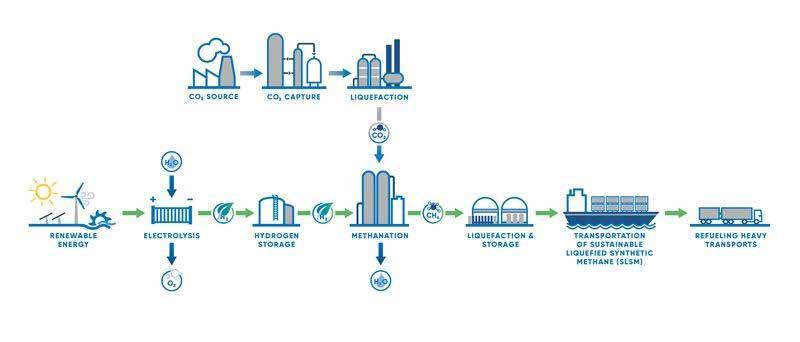
Earlier this year, the project was awarded the Powerto-X Innovation Award at the Tamarindo Global Wind Investment Awards ceremony.
Wärtsilä Gas Solutions is a market leader with innovative systems and lifecycle solutions for the gas value chain. Our main focus areas are the handling of gas in seaborne transport (storage, fuel, transfer and BOG management), gas to power, liquefaction and biogas solutions. We help our customers on their journey towards a sustainable future through a focus on lifecycle performance, innovation and digitalisation.
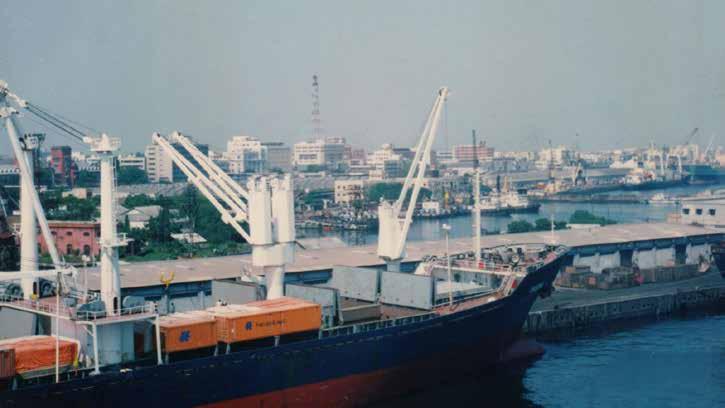
India is blessed with a long coastline of 7500 kms and 14,000 kms of navigable rivers. India is one of the fastest growing economies of the world.
To sustain this economic growth & maintain the momentum, it is critical for India to keep logistics cost under control. Logistics cost in India presently is 16%
of GDP whereas for developed economies it is 8-10%. Ocean haulage is the cheapest mode of transport as compared to road and rail. Coastal shipping involves the transportation of goods along the coast over relatively short distances. In India share of Coastal Shipping is barely 6-7%. 60 % of the freight is transported through the roads, 31% by rail, as compared to international benchmark of 25-30% road; 50-55% railways, 20-25% share of waterways.
The Indian coastline is underutilised for coastal shipping despite several Govt. Initiatives. Reasons cited have been various and includes limited back haul opportunities, multiple handling, last mile logistical challenge, policy regulations etc.
Govt. of India is committed to increasing the Coastal Shipping from 6-7% to 12 -14% by 2025. To support this commitment, Govt. has introduced initiatives and incentives to promote Coastal Shipping in India.
Assuming above impediments are addressed in a progressive manner, Coastal shipping will drive significant economic benefits by not only removing supply chain bottlenecks ensuring smooth flow of traffic but also help in the full utilisation of minor ports on the coast.
The cost advantages of coastal shipping particularly for the movement of cargo in bulk will reduce India’s reliance on imported fuel while also supporting the ambitious GHG emission targets through a greener & cleaner mode of transport as compared to road and rail.CO2 emission is the highest through road transport.
Increasing Coastal shipping will require faster turnaround in ports, custom made coastal vessels like the RSP 4 or better with good speed and consumption, optimum port costs etc.as it has to compete with road transportation with respect to time and cost.

As these benefits kick in, the rate of returns on assets deployed will significantly improve. The bottom-line improvement will drive top-line revenue. This in turn will attract more volume over the coastal mode assisting all supply chain partners & stakeholders save costs within their respective domain.
There are numerous infrastructural, Statutory and Operational challenges for converting cargoes from road and rail mode to coastal mode. Road and rail connectivity needs to be scaled up to ensure seamless transition. Various facilities in minor ports like storage, stacking areas, clearing facilities will need a make-over which would boost customer confidence. Other barriers hindering the development include the complex taxation, custom duty on ship fuel to be paid by ship owners / operators etc.
The advantage of Coastal shipping far outweighs the efforts needed to build the regulatory & infrastructure framework. There is going to be huge cost savings for all parties involved. Operational efficiencies will drive service excellence with more consistent and reliable transit times. The net outcome would be taking trucks off the road which reduces the congestion & spend needed to maintain road infrastructure. A huge decrease in air pollution leading to a positive carbon footprint with less pilferage & theft.
Coastal shipping is ideal for Project Cargoes, RORO & variety of dry bulk cargo such as coal, grain, fertilizers, steel, metals and minerals. Liquid bulk cargo such as crude, Diesel and other fuel-based products only stand to benefit from this modal.
Coastal shipping checks all boxes from financial & environmental perspective.
* Project Unnati
- Over 116 Initiatives of which 95 have been implemented as of 2021 and 12 are under implementation. This includes several infrastructure improvements measures to operational efficiency. New policies that encourage public/ private partnership to enhance connectivity with Hinterland market
* Sagarmala Initiatives
- This includes over 114 road and 23 rail connectivity projects. There are also 111 national waterway projects that has been identified for development. Building economiczones that could converted into key manufacturing hubs could span 300-500 Kms ofthe coastline. Paradip & Haldia have been identified to be developed as 2 smart Industrial port cities.
* Financial Initiatives
- A robust financial incentive policy that provides 10-year tax holiday for enterprises that develop, maintain, and operate ports and inland waterways. Subsidising berth hire costs for coastal vessels & providing relief on pilotage & port dues along with Cabotage relaxation enables a focused approach to create enough stimulus for this segment.
High level Challenges:
* Infrastructure~
• Major consumption and cargo generating centres are not near the port
• Inadequate last mile connectivity
• Poor Connectivity between coastal areas and hinterland
* Regulatory~
• High Bunker Prices
• Complex Taxation
• Cabotage Law
• Trade structure not duty friendly
* Operational~
• High Port Costs
• Lack of bunkering facilities
• Congestion
PMGatiShakti aims to build a welldeveloped logistics and supply chain network, which will allow goods to flow seamlessly across borders and increase access to global markets, said Mr Som Parkash, Union Minister of State for Commerce & Industry at the National Conference on Gati Shakti-Boosting connectivity for New India: Logistics – Warehousing - Supply Chain” organised by the Associated Chambers of Commerce and Industry of India (ASSOCHAM).
In his address, Mr Parkash mentioned that states/ Union Territories of the country are extensively using the PM GatiShakti approach for planning connectivity
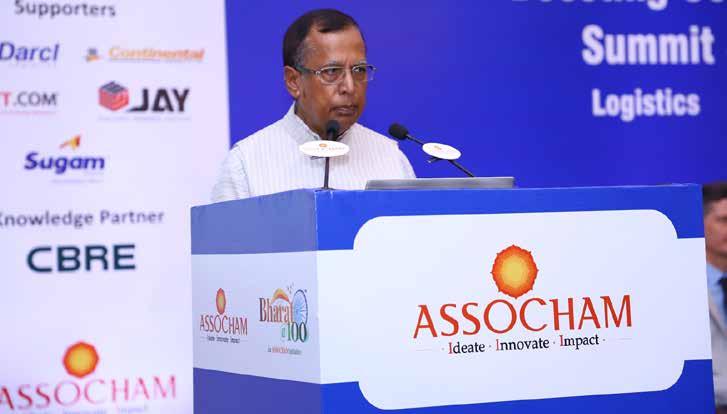
to Industrial Regions; for deciding on location of social infrastructure assets, such as schools, hospitals, etc.
On PM GatiShakti NMP, Mr Prakash commented that the National Logistics Policy aims to bring efficiency in logistics services and human resources. The policy intents to reduce the cost of logistics, improve India’s ranking in Logistics Performance Index, enabling data-driven decision support mechanism for an efficient logistics ecosystem.
“This is a strong indicator of India’s global positioning, with this development being powered by our government’s laser focus on reforms for improving
logistics infrastructure through PM GatiShakti and National Logistics Policy,” he expressed.
Mr Rajesh Pandit, Managing Director, GWS India, PM - India, Middle East, Southeast Asia and North Africa, CBRE articulated, “As the GatiShakti Master Plan unfolds, its core focus on enhancing logistical efficiency and strengthening connectivity is expected to drive strategic growth nationwide. Subsequently, as logistics infrastructure improves, there will be a surge in demand for warehousing, distribution centers, and industrial parks, presenting compelling opportunities for mixed-use developments and retail spaces. The plan’s concerted efforts to enhance multi-model connectivity will unlock the untapped potential, fostering inclusive economic growth and propelling India towards a promising future.
Beyond its transformative impact on infrastructure and logistics, the Gati Shakti Master Plan also holds the potential to significantly increase employment opportunities across the country. As the plan forges ahead, CBRE, wholeheartedly supports the government’s Gati Shakti initiative and is committed to contributing to its resounding success”.
In his welcome address, Mr Hitender Mehta, CoChair, National Council on SEZs, Industrial Parks and Warehousing, ASSOCHAM informed that logistics and supply chain management play a major role in the economy and market demands. Various initiatives and release of National Logistics policy by PM are some milestones to bring down the logistics cost to 7-8% and increase ease of doing business. These will
reduce the course of transactions and lead a strong logistics support system and simplify the business.
Mr Yuvraj Sharma, Cluster Head – Sales & Marketing India, Sri Lanka and Maldives, Kuehne+Nagel Group stated that Indian logistics market is expected to be close to $425 million and a growth with 8.5% rate in the next 17 years. He highlighted that the biggest superpower under Gati Shakti are visibility of cargo and waterway navigation.
Lt Col Jitender Yadav, Founder, Pragati Group highlighted that India has risen 6 points in world logistics performance index. Point of concern of the logistic course is that it is 15% higher comparatively to a developed nation with 7-8 %. Warehousing sector development faces problems like land acquisition and land costs.
Mr Christian Kapfensteiner, Director, Sustainable Urban and Industrial Development, Deutsche Gesellschaft für technische Zusammenarbeit (GIZ) GmbH, India pointed out that multi model connectivity should be implemented to develop infrastructure to reduce logistics cost. Larger focus should be on Digitalization, Connectivity, Delivery Time, Tax incentives, and Skill development to sustain the sector.
A joint Knowledge report was released by ASSOCHAM and CBRE by eminent dignitaries and industrialists on the theme Gati Shakti: Boosting Connectivity for New India.
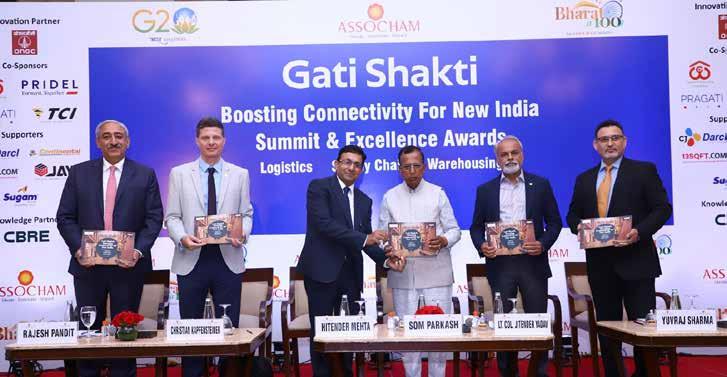

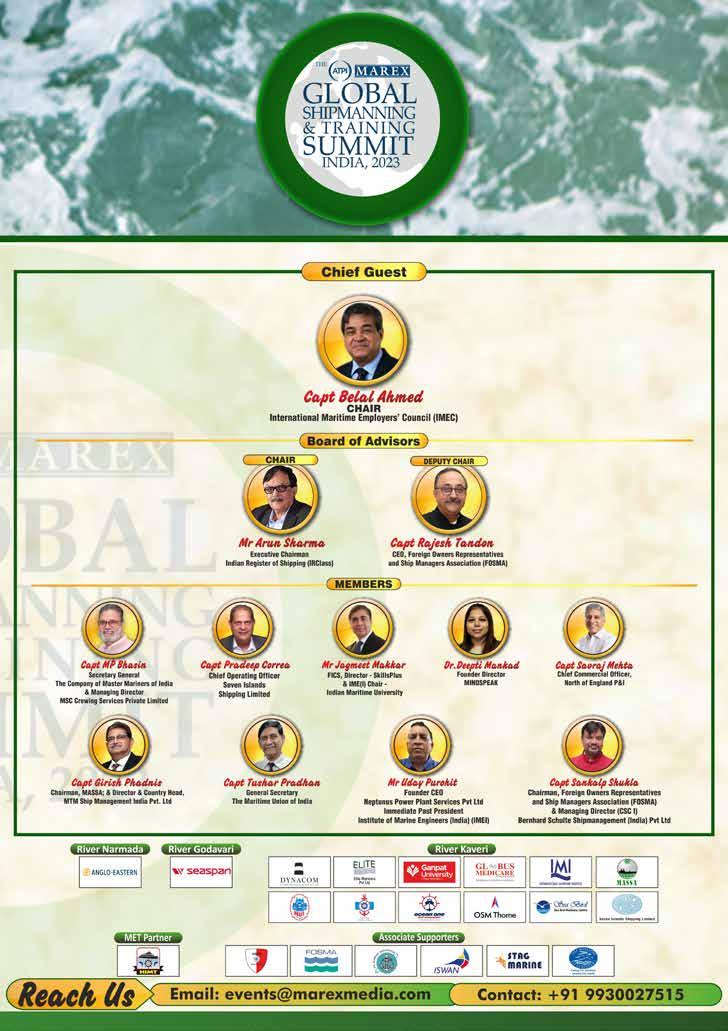


GAC India is in the business of growing yours. Leveraging our domestic logistics know-how and comprehensive local network, we deliver your B2B cargo on time, on target, on budget. For seamless supply chain services that extend your reach, trust GAC.
gac.com/india
For enquiries, contact us at india@gac.com
GAC Shipping (India) Private Limited
Main office
GAC House, P.B. No. 515, Subramanian Road, Willingdon Island, Cochin 682 003, India
T: +91 484 266 8372
CIN: U63090KL1983PTC003733
Operating from branch offices across India: Bengaluru | Chennai | Dhamra | Goa | Haldia | Indore | Jamnagar | Kakinada | Kandla | Kochi | Kolkata | Krishnapatnam | Mangalore | Mumbai | Mundra | New Delhi | Nhava Sheva | Paradip | Pipavav | Port Blair | Pune | Surat | Tuticorin | Visakhapatnam
fb.com/GACshippingindiapvtltd instagram.com/gacshippingindia

